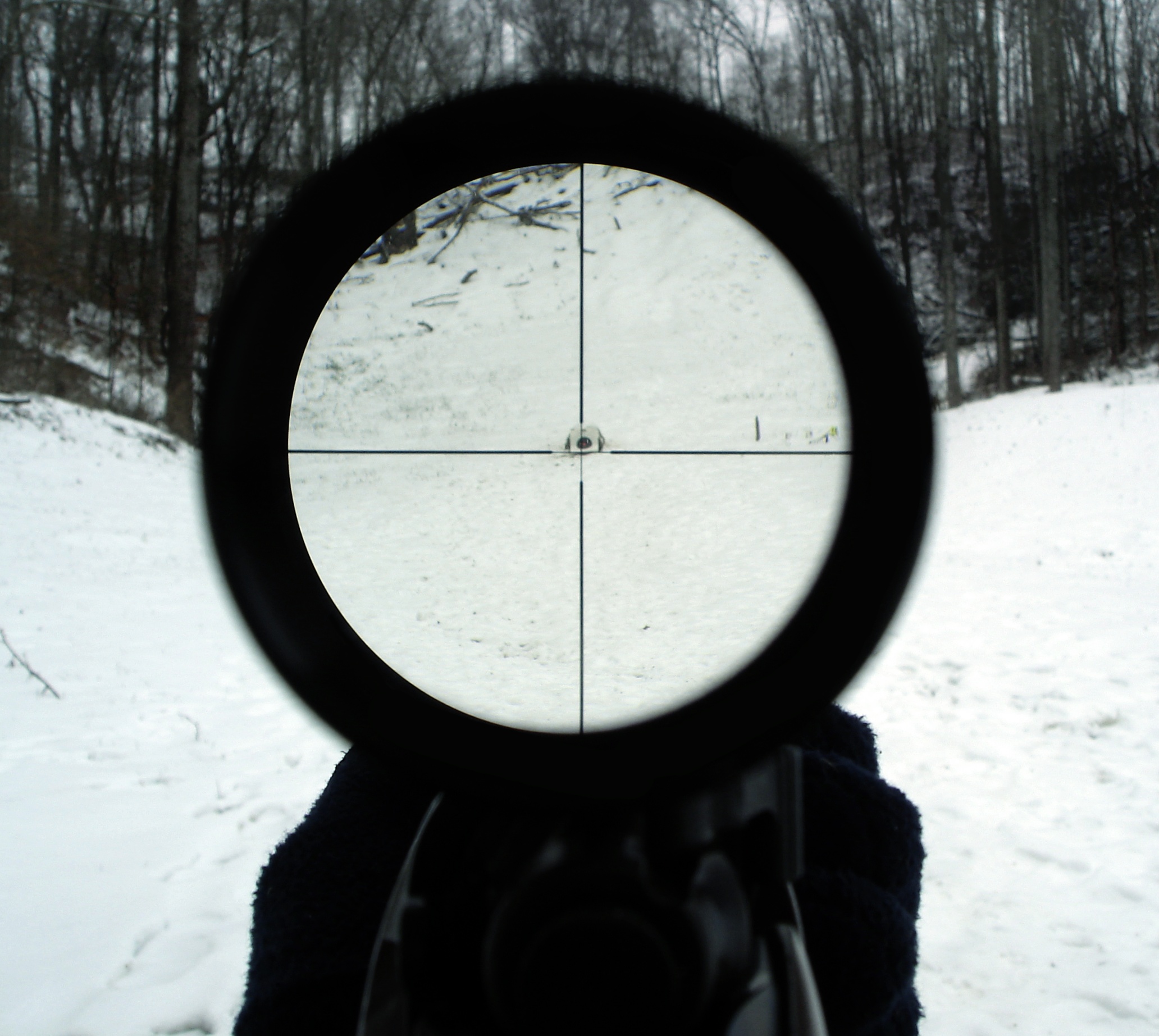|
Monocular
A monocular is a compact refracting telescope used to magnify images of distant objects, typically using an optical prism to ensure an erect image, instead of using relay lenses like most telescopic sights. The volume and weight of a monocular are typically less than half of a pair of binoculars with similar optical properties, making it more portable and also less expensive. This is because binoculars are essentially a pair of monoculars packed together — one for each eye. As a result, monoculars only produce two-dimensional images, while binoculars can use two parallaxed images (each for one eye) to produce binocular vision, which allows stereopsis and depth perception. Monoculars are ideally suited to those applications where three-dimensional perception is not needed, or where compactness and low weight are important (e.g. hiking). Monoculars are also sometimes preferred where difficulties occur using both eyes through binoculars due to significant eyesight variation ( ... [...More Info...] [...Related Items...] OR: [Wikipedia] [Google] [Baidu] |
Stereopsis
Binocular vision is seeing with two eyes, which increases the size of the Visual field, visual field. If the visual fields of the two eyes overlap, binocular #Depth, depth can be seen. This allows objects to be recognized more quickly, camouflage to be detected, spatial relationships to be perceived more quickly and accurately(#Stereopsis, stereopsis) and perception to be less susceptible to optical illusions, optical illusions. In #Medical, medical attention is paid to the occurrence, defects and sharpness of binocular vision. In #Biological, biological the occurrence of binocular vision in animals is described. Geometric terms When the left eye (LE) and the right eye (RE) observe two objects X and Y, the following concepts are important: Egocentric distance The ''egocentric distance'' to object X is the distance from the observer to X. In the figure: Dx. Metric depth The ''metric depth'' between two objects X and Y is the difference of the egocentric distances to X and Y. In ... [...More Info...] [...Related Items...] OR: [Wikipedia] [Google] [Baidu] |
Binocular Vision
Binocular vision is seeing with two eyes. The Field_of_view, field of view that can be surveyed with two eyes is greater than with one eye. To the extent that the visual fields of the two eyes overlap, #Depth, binocular depth can be perceived. This allows objects to be recognized more quickly, camouflage to be detected, spatial relationships to be perceived more quickly and accurately (#Stereopsis, stereopsis) and perception to be less susceptible to optical illusions, optical illusions. In secion #Medical, Medical attention is paid to the occurrence, defects and sharpness of binocular vision. In section #Biological, Biological the occurrence of binocular vision in animals is described. Geometric terms When the left eye (LE) and the right eye (RE) observe two objects X and Y, the following concepts are important:Krol J.D.(1982),"Perceptual ghosts in stereopsis, a ghosly problem in binocular vision", PhD thesis ISBN 90-9000382-7.Koenderink J.J.;van Doorn A.J. (1976) "Geometry of ... [...More Info...] [...Related Items...] OR: [Wikipedia] [Google] [Baidu] |
Depth Perception
Depth perception is the ability to perceive distance to objects in the world using the visual system and visual perception. It is a major factor in perceiving the world in three dimensions. Depth sensation is the corresponding term for non-human animals, since although it is known that they can sense the distance of an object, it is not known whether they perceive it in the same way that humans do. Depth perception arises from a variety of depth cues. These are typically classified into binocular cues and monocular cues. Binocular cues are based on the receipt of sensory information in three dimensions from both eyes and monocular cues can be observed with just one eye. Binocular cues include retinal disparity, which exploits parallax and vergence. Stereopsis is made possible with binocular vision. Monocular cues include relative size (distant objects subtend smaller visual angles than near objects), texture gradient, occlusion, linear perspective, contrast differences, a ... [...More Info...] [...Related Items...] OR: [Wikipedia] [Google] [Baidu] |
Visual Impairment
Visual or vision impairment (VI or VIP) is the partial or total inability of visual perception. In the absence of treatment such as corrective eyewear, assistive devices, and medical treatment, visual impairment may cause the individual difficulties with normal daily tasks, including reading and walking. The terms ''low vision'' and ''blindness'' are often used for levels of impairment which are difficult or impossible to correct and significantly impact daily life. In addition to the various permanent conditions, fleeting temporary vision impairment, amaurosis fugax, may occur, and may indicate serious medical problems. The most common causes of visual impairment globally are uncorrected refractive errors (43%), cataracts (33%), and glaucoma (2%). Refractive errors include near-sightedness, far-sightedness, presbyopia, and astigmatism (eye), astigmatism. Cataracts are the most common cause of blindness. Other disorders that may cause visual problems include age-related macular ... [...More Info...] [...Related Items...] OR: [Wikipedia] [Google] [Baidu] |
Binoculars
Binoculars or field glasses are two refracting telescopes mounted side-by-side and aligned to point in the same direction, allowing the viewer to use both eyes (binocular vision) when viewing distant objects. Most binoculars are sized to be held using both hands, although sizes vary widely from opera glasses to large pedestal-mounted military models. Unlike a (monocular) telescope, binoculars give users a stereopsis, three-dimensional image: each eyepiece presents a slightly different image to each of the viewer's eyes and the parallax allows the visual cortex to generate an depth perception, impression of depth. Optical design evolution Galilean Almost from the invention of the telescope in the 17th century the advantages of mounting two of them side by side for binocular vision seems to have been explored. Most early binoculars used Galilean telescope, Galilean optics; that is, they used a convex lens, convex objective (optics), objective and a concave lens, concave eyepi ... [...More Info...] [...Related Items...] OR: [Wikipedia] [Google] [Baidu] |
Amblyopia
Amblyopia, also called lazy eye, is a disorder of sight in which the brain fails to fully process input from one eye and over time favors the other eye. It results in decreased vision in an eye that typically appears normal in other aspects. Amblyopia is the most common cause of decreased vision in a single eye among children and younger adults. The cause of amblyopia can be any condition that interferes with focusing during early childhood. This can occur from poor alignment of the eyes (strabismic), an eye being irregularly shaped such that focusing is difficult, one eye being more nearsighted or farsighted than the other (refractive), or clouding of the lens of an eye (deprivational). After the underlying cause is addressed, vision is not restored right away, as the mechanism also involves the brain. Amblyopia can be difficult to detect, so vision testing is recommended for all children around the ages of four to five as early detection improves treatment success. Glas ... [...More Info...] [...Related Items...] OR: [Wikipedia] [Google] [Baidu] |
Strabismus
Strabismus is an eye disorder in which the eyes do not properly align with each other when looking at an object. The eye that is pointed at an object can alternate. The condition may be present occasionally or constantly. If present during a large part of childhood, it may result in amblyopia, or lazy eyes, and loss of depth perception. If onset is during adulthood, it is more likely to result in diplopia, double vision. Strabismus can occur out of muscle dysfunction (e.g., myasthenia gravis), farsightedness, problems in the brain, trauma, or infections. Risk factors include premature birth, cerebral palsy, and a family history of the condition. Types include esotropia, where the eyes are crossed ("cross eyed"); exotropia, where the eyes diverge ("lazy eyed" or "wall eyed"); and hypertropia or hypotropia, where they are vertically misaligned. They can also be classified by whether the problem is present in all directions a person looks (comitant) or varies by direction (inco ... [...More Info...] [...Related Items...] OR: [Wikipedia] [Google] [Baidu] |
Telescopic Sight
A telescopic sight, commonly called a scope informally, is an optical sighting device based on a refracting telescope. It is equipped with some form of a referencing pattern – known as a ''reticle'' – mounted in a focally appropriate position in its optical system to provide an accurate point of aim. Telescopic sights are used with all types of systems that require magnification in addition to reliable visual aiming, as opposed to non-magnifying iron sights, reflector (reflex) sights, holographic sights or laser sights, and are most commonly found on long-barrel firearms, particularly rifles, usually via a scope mount. Similar devices are also found on other platforms such as artillery, tanks and even aircraft. The optical components may be combined with optoelectronics to add night vision or smart device features. History The first experiments directed to give shooters optical aiming aids go back to the early 17th century. For centuries, different optical ... [...More Info...] [...Related Items...] OR: [Wikipedia] [Google] [Baidu] |
Optical Path
Optical path (OP) is the trajectory that a light ray follows as it propagates through an optical medium. The geometrical optical-path length or simply geometrical path length (GPD) is the length of a segment in a given OP, i.e., the Euclidean distance integrated along a ray between any two points. The mechanical length of an optical device can be reduced to less than the GPD by using folded optics. The '' optical path length'' in a homogeneous medium is the GPD multiplied by the refractive index of the medium. Factors affecting optical path Path of light in medium, or between two media is affected by the following: * Reflection ** Total internal reflection * Refraction * Dispersion of light * Absorption Simple materials used * Lenses * Prisms * Mirror A mirror, also known as a looking glass, is an object that Reflection (physics), reflects an image. Light that bounces off a mirror forms an image of whatever is in front of it, which is then focused through the lens ... [...More Info...] [...Related Items...] OR: [Wikipedia] [Google] [Baidu] |
Porro Prism
In optics, a Porro prism, named for its inventor Ignazio Porro, is a type of ''reflection prism'' used in optical instruments to alter the orientation of an image. Description It consists of a block of material shaped like a right geometric prism with right-angled triangular end faces. In operation, light enters the large rectangular face of the prism, undergoes total internal reflection twice from the sloped faces, and exits again through the large rectangular face. When the light enters and therefore exits the glass at normal incidence, the prism is not dispersive. An image travelling through a Porro prism is rotated by 180° and exits in the opposite direction offset from its entry point. While a single Porro prism can be constructed to work as well as a roof prism, it is seldom used as such. Therefore, to reduce the cost of production for a Porro prism, the edge of the roof is usually left out. Sometimes only one small window as an entrance surface and one window as e ... [...More Info...] [...Related Items...] OR: [Wikipedia] [Google] [Baidu] |






